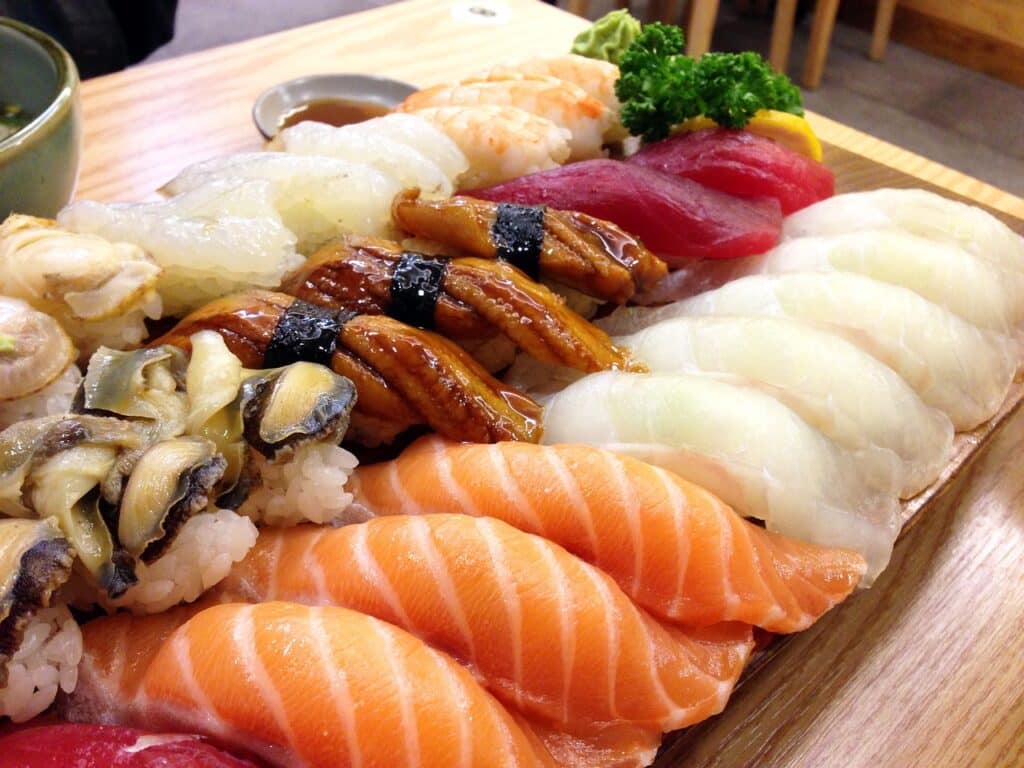Sushi, one of the most popular dishes in Japan, is a culinary art form that has captivated food lovers worldwide. It’s more than just a meal; it’s an experience steeped in tradition and cultural significance.
Our team at Remitly created this guide as part of our series that celebrates the traditional foods of our global customers.
The History of Sushi in Japan
The history of sushi in Japan dates back to the 8th century. Originally, sushi was a method of preserving fish by fermenting it with rice.
Over time, this preservation technique evolved into what we now recognize as sushi.
In the Edo period (1603-1868), sushi underwent significant changes. Street vendors began serving ‘narezushi’—a quick, portable snack for busy city dwellers. This marked the birth of modern-day sushi.
Ingredients Used in Traditional Sushi
Traditional sushi ingredients are simple yet flavorful. At its core, sushi consists of vinegared rice paired with various toppings or fillings.
The most common topping is raw fish—tuna, salmon, and mackerel are popular choices. Other ingredients include vegetables like cucumber and pickled radish, and ‘nori’—seaweed sheets used to wrap the sushi.
A Simple Japanese Sushi Recipe for Beginners
Ingredients:
- 2 cups of sushi rice
- 1/4 cup of rice vinegar
- 10 sheets of nori
- 1 cucumber, thinly sliced
- 1 avocado, thinly sliced
- 200g fresh salmon or tuna, thinly sliced
- Soy sauce for dipping
Instructions:
- Rinse the sushi rice under cold water until the water runs clear. Cook according to package instructions.
- Once cooked, let the rice cool slightly before mixing in the rice vinegar.
- Place a sheet of nori on a bamboo sushi mat. Spread a thin layer of vinegared rice over the nori, leaving about an inch free at the top.
- Arrange your chosen fillings in a line down the center of the rice.
- Roll up tightly using the bamboo mat, applying pressure to keep everything compact.
- Slice into bite-sized pieces using a sharp knife.
- Repeat with remaining ingredients.
- Serve with soy sauce for dipping.
Remember, practice makes perfect when it comes to making sushi!
Different Types of Sushi
There are several types of sushi, each with its unique characteristics. ‘Nigiri’ features thinly sliced raw fish atop vinegared rice—a minimalist approach that highlights the freshness of the seafood.
‘Maki’, on the other hand, is rolled sushi wrapped in nori. It often includes multiple fillings such as fish and vegetables—an explosion of flavors in every bite.
Etiquette and Customs Around Eating Sushi
Eating sushi comes with its own set of etiquette and customs. For instance, it’s customary to eat sushi with your hands—not chopsticks.
When dipping sushi in soy sauce, only the fish should touch the sauce—not the rice. This prevents the rice from falling apart and maintains the balance of flavors.
Influence of Japanese Sushi on Global Cuisine
Japanese sushi has had a profound influence on global cuisine. Today, you can find sushi restaurants in nearly every corner of the world—each adding their unique twist to this traditional dish.
In America, ‘California rolls’ have become a staple—a fusion creation featuring avocado and crab meat. Meanwhile, countries like Korea have incorporated local ingredients into their versions of sushi—showcasing cultural exchange through food.
The Broader Cuisine of Japan
Japanese cuisine is as diverse as it is delicious—each region boasting its own unique dishes and flavors.
Ramen: A Comfort Food Staple
Ramen is one such dish that has gained international acclaim—a comforting bowl of noodles served in a flavorful broth with various toppings like meat and vegetables.
Tempura: Lightly Battered Delights
Tempura is another well-known Japanese dish—seafood or vegetables lightly battered and deep-fried to perfection.
Yakitori: Grilled Skewers
Yakitori—grilled skewers typically made from chicken—are popular street food items often enjoyed with beer at casual dining establishments known as ‘izakayas’.
Miso Soup: A Daily Essential
Miso soup, made from fermented soybean paste, is a staple in Japanese cuisine—often served as part of a traditional breakfast.
Matcha: The Art of Tea
Matcha, a type of powdered green tea, plays an integral role in Japanese culture. It’s not only used in the traditional tea ceremony but also incorporated into various desserts and sweets.
Japanese cuisine is a testament to the country’s rich cultural heritage—a blend of tradition and innovation that continues to captivate food lovers around the world.
Visit the homepage, download our app, or check out our Help Center to get started.
